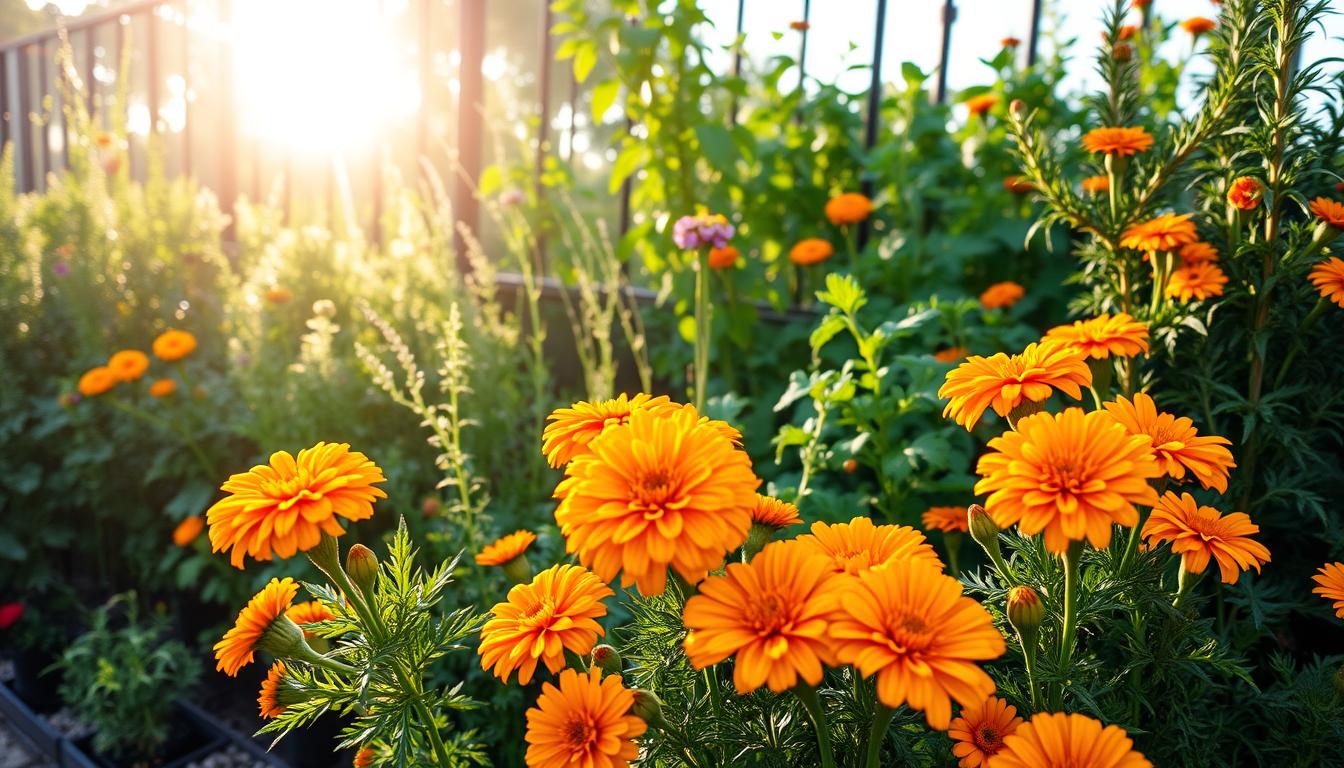Imagine stepping into your garden, where the sun’s golden rays dance upon vibrant blooms, and the air is filled with the sweet, earthy scent of life. Your heart swells with pride as you witness the harmony flourishing before you—not just from the colors of the flowers, but from the interconnectedness of nature that thrives within your little patch of paradise. By embracing marigold companion plants, you can create this vivid tableau, enhancing not only the appearance of your garden but also its health and productivity. Marigolds are vibrant allies, working tirelessly to bolster the well-being of your vegetables, herbs, and other flowers. Let’s explore how these delightful floral companions can transform your gardening experience and lead you on a journey toward a thriving garden ecosystem.
Key Takeaways
- Marigolds enhance the health and vibrancy of your garden.
- The best companion plants for marigolds can naturally deter pests.
- Strategically planted marigold combinations can boost productivity.
- Marigolds thrive alongside a variety of vegetables and herbs.
- Understanding companion planting elevates your gardening skills.
What Are Marigold Companion Plants?
Marigold companion plants are those that thrive alongside marigolds, creating a harmonious garden environment. These partnerships enhance mutual growth, offering benefits such as increased pest resistance and improved soil health. Exploring marigold companion planting ideas can lead to a more vibrant and productive garden.
The Benefits of Companion Planting
Companion planting provides numerous advantages for your garden. By introducing marigold garden companions, you can experience effective natural pest control, healthier soil, and enhanced pollinator attraction. This approach fosters a balanced ecosystem that supports plant health and growth, allowing your garden to flourish.
Types of Marigolds to Consider
Several types of marigolds can serve as excellent companions in the garden. French marigolds (Tagetes patula) are popular for their compact size and vibrant blooms. African marigolds (Tagetes erecta) stand taller and add a splash of color, while Signet marigolds (Tagetes tenuifolia) are prized for their delicate flowers. Choosing the right marigold can elevate your marigold vegetable companions and the overall landscape of your garden.
How Marigolds Help Other Plants
Marigolds play a crucial role in assisting surrounding plants. Their ability to deter pests like nematodes and aphids makes them invaluable to vulnerable crops. By incorporating marigolds into your garden, you can create a thriving space where various plants benefit from their presence, leading to a more resilient and productive garden environment.

Ideal Gardening Conditions for Marigolds
Creating the right environment for marigolds can significantly enhance their growth and effectiveness as marigold companion plants. Understanding their preferred conditions ensures that you enjoy vibrant blooms and robust health in your garden.
Soil Requirements
Marigolds flourish in well-drained, fertile soil with a pH level of 6 to 7. A soil rich in organic matter provides essential nutrients, promoting healthy growth. To achieve ideal conditions, consider incorporating aged compost into your garden bed. This not only improves soil structure but also supports beneficial microbes that help marigold planting partners thrive.
Sunlight and Water Needs
These flowers thrive in full sun, needing at least six hours of sunlight per day. Proper exposure ensures that marigolds blossom beautifully, warding off pests and diseases. Initial watering is crucial for establishment; the soil should be kept moist but not soggy. Once your marigolds are established, their drought tolerance kicks in, reducing the need for frequent watering and allowing for a more straightforward maintenance routine.

Best Vegetables to Pair with Marigolds
When planning your vegetable garden, considering marigold vegetable companions can significantly enhance both yield and health. These vibrant flowers not only add color but also provide protective benefits for various crops. Here are some excellent marigold plant combinations to boost your home garden.
Tomatoes and Marigolds: A Perfect Match
Tomatoes thrive alongside marigolds. The roots of marigolds release compounds that repel harmful root-knot nematodes, which can damage tomato plants. This pairing creates a healthier environment for your tomatoes, contributing to improved growth and fruit production.
Marigolds with Cucumbers: Pest Control Benefits
Cucumbers can also benefit from the presence of marigolds. These flowers naturally deter pests such as aphids and beetles that commonly afflict cucumbers. Including marigolds in your cucumber beds will not only help protect your plants but can also attract beneficial insects that promote a balanced garden ecosystem.
Peppers and Marigolds: Enhancing Growth
Using marigolds around pepper plants offers numerous advantages. They help lure away pests, providing a safer growing environment. Additionally, marigold plant combinations can enhance the overall health of pepper plants, leading to a more abundant harvest.

Flowers That Make Great Companions for Marigolds
In addition to their benefits alongside vegetables, marigold flower bed companions include several vibrant flowering plants. These companions not only enhance your garden’s aesthetic but also play a role in attracting beneficial pollinators and deterring pests. Discover how marigolds can harmoniously coexist with zinnias, nasturtiums, and petunias.
Marigolds and Zinnias: A Colorful Combination
Zinnias are known for their bright colors and cheerful blooms. Pairing zinnias with marigolds creates a visually striking display in your garden. This combination attracts butterflies and bees, enriching the overall ecosystem of your garden. The different heights and textures of these flowers provide depth, making your garden more appealing.
Combining Marigolds with Nasturtiums
Nasturtiums offer a unique look with their trailing vines and edible flowers. When planted alongside marigolds, they provide not only visual contrast but also a natural pest deterrent. Nasturtiums attract aphids, keeping them away from your marigold flower bed companions and other nearby plants. This synergy boosts your garden’s overall health.
Enhancing Your Garden with Petunias
Petunias are another excellent option to pair with marigolds. Their bright colors and varied shapes complement marigolds beautifully. Like marigolds, petunias are known for repelling certain pests, increasing the protective benefits they offer. Adding petunias helps to create a lush environment that flourishes with life.

Herbs That Thrive Alongside Marigolds
Integrating the right herbs with your marigold plants can create a harmonious garden. Marigold herb companions not only enhance growth but also provide pest control benefits. Notably, herbs like basil and dill work exceptionally well with marigolds, making your garden vibrant and productive.
Basil and Marigolds: Flavor and Color
Basil, when planted alongside marigolds, thrives in the protective environment created by these cheerful flowers. The aroma of marigolds masks the distinct scent of basil, which helps deter pests such as aphids. Additionally, the vibrant colors of both plants create an eye-catching display that enhances the overall aesthetics of your garden.
Dill and Marigolds: Attracting Beneficial Insects
Dill is another fantastic option that pairs well with marigolds. This herb attracts pollinators like bees and butterflies, thriving in an environment enriched by marigolds. As dill and marigolds grow together, they create a supportive ecosystem that helps maintain healthy growth while fostering beneficial insect activity. Utilizing these marigold herb companions ensures a flourishing garden full of life.

| Herb | Benefit of Marigold Companions | Pest Deterrent |
|---|---|---|
| Basil | Enhances growth and flavor | Aphids |
| Dill | Attracts pollinators | Various pests |
Creating a Pest-Resistant Garden
Developing a pest-resistant garden can be one of the most rewarding aspects of gardening. Marigolds emerge as a powerful tool in your quest for a healthier garden. Their strong scent and natural ability to repel common garden pests make them invaluable. By integrating marigold companion planting ideas into your garden design, you can significantly reduce the likelihood of pest infestations.
How Marigolds Deter Pests
Marigolds possess unique properties that make them effective in deterring unwanted pests. The scent emitted by these vibrant flowers acts as a natural repellent against common foes, such as aphids, spider mites, and nematodes. Incorporating marigolds into your garden not only beautifies the landscape but also creates a natural barrier, helping your other plants thrive in a more secure environment.
Other Plants That Work Well with Marigolds
To further enhance your pest-resistant garden, consider adding other companion plants that work well with marigolds. Some excellent choices include:
- Lavender: Its aromatic qualities help keep harmful insects at bay.
- Calendula: Similar to marigolds, calendula offers pest-repelling properties and brightens your garden.
- Basil: Not only useful in the kitchen, but it can also deter flies and mosquitoes.
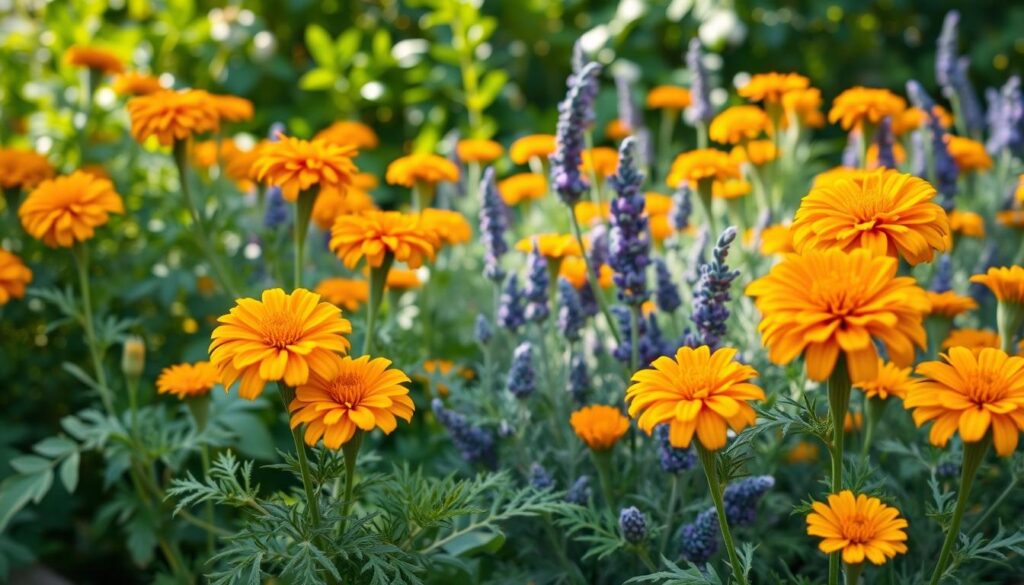
Combining these plants with marigolds maximizes the effectiveness of your pest-resistant garden. A strategic approach to selecting companions will ensure that all your plants flourish while minimizing risks posed by pests.
| Plant | Pest Deterrent Qualities |
|---|---|
| Marigolds | Repels aphids, spider mites, and nematodes |
| Lavender | Keeps harmful insects away with its scent |
| Calendula | Bright flowers that repel pests |
| Basil | Deters flies and mosquitoes effectively |
Implementing a combination of these plants can transform your space into a flourishing, pest-resistant garden that invites beneficial insects while driving away the unwanted ones.
The Role of Marigolds in Pollinator Gardens
Incorporating marigolds into your garden can significantly enhance its appeal to various pollinators such as bees and butterflies. These vibrant flowers not only diversify your landscape but also contribute to a healthier ecosystem. As you consider making your garden a haven for these beneficial insects, marigolds serve as excellent garden companions, thanks to their bright colors and extended blooming periods.
Attracting Bees and Butterflies with Marigolds
Marigolds are known for their ability to attract a variety of pollinators. The bright orange and yellow hues of their petals draw the attention of bees and butterflies, encouraging them to visit your garden repeatedly. This repeated visitation fosters better pollination of your fruits and vegetables, promoting a thriving garden environment. When you plant marigolds along with other pollinator-friendly plants, you create a bustling ecosystem that supports these essential insects.
Other Pollinator-Friendly Plants
Pairing marigolds with a selection of other pollinator-friendly plants can maximize the benefits to your garden. Consider integrating the following plants:
- Lavender
- Echinacea (Coneflower)
- Bee Balm
- Sunflowers
- Cosmos
These plants not only coexist well with marigolds but also provide diverse nectar sources for pollinators. By cultivating a variety of colors and types, you will encourage more insects to frequent your garden.

Seasonal Considerations for Marigold Planting
Timing plays an essential role in ensuring the success of your marigold companion plants. Understanding seasonal planting tips helps you create a thriving garden. By preparing accordingly for spring and summer, you can enhance growth and maximize flowering potential.
Spring Planting Tips
Plant marigolds in the spring after the last frost has passed. This timing is crucial for establishing healthy plants. When selecting a location, choose a spot with plenty of sunlight and well-drained soil. Prepare the area by loosening the soil and mixing in compost for added nutrients. Once planted, regularly monitor moisture levels to keep the young plants hydrated but not saturated.
Summer Care for Marigolds
As the weather warms, focus on ongoing care for your marigold companion plants. Regular watering becomes vital, especially during dry spells. Consider deadheading any spent blooms to encourage new growth and prolong the flowering period. This simple practice not only keeps your garden looking vibrant but also ensures that marigolds effectively attract beneficial insects and deter pests.

| Season | Activity | Considerations |
|---|---|---|
| Spring | Planting marigolds | Wait until after the last frost |
| Spring | Soil preparation | Add compost for nutrients |
| Summer | Watering | Keep soil consistently moist |
| Summer | Deadheading | Remove spent blooms for continuous flowers |
Marigold Varieties for Different Climates
Understanding the right marigold varieties for your specific climate can elevate your gardening experience. Choosing climate-specific marigolds not only enhances their growth but also amplifies the benefits when combined with other plants. Different regions have unique needs, so aligning your selections with your environmental conditions is crucial.
Choosing Marigolds for Warm Climates
If you live in a warmer climate, African marigolds are an excellent option as they thrive with ample sunlight and warmth. These vibrant blooms can reach impressive heights and add bold colors to your garden. French marigolds are another versatile choice, known for their adaptability and pest-repelling qualities. Pairing these varieties in your garden can result in effective marigold companion planting ideas.
Varieties Suited for Cooler Areas
For those in cooler climates, opting for shorter-season varieties proves beneficial. One option is the Signet marigold, which showcases charming golden-yellow flowers while requiring less sunlight than its larger counterparts. This variety fits well into gardens that experience more shade, allowing you to creatively implement marigold companion planting ideas even in less-than-ideal conditions. Selecting these climate-specific marigolds ensures that they thrive and enhance your garden’s overall health and visual appeal.

| Climate Type | Marigold Variety | Characteristics |
|---|---|---|
| Warm Climates | African Marigolds | Tall, vibrant, and sun-loving |
| Warm Climates | French Marigolds | Versatile, pest-repelling |
| Cooler Climates | Signet Marigolds | Shorter season, thrives in shade |
How to Care for Marigold Companion Plants
Caring for your marigold planting partners is vital for maintaining their health and blooming potential. Successful marigold care includes a focus on watering, fertilization, and regular maintenance practices. Following these guidelines ensures vibrant and flourishing plants that complement your garden beautifully.
Watering and Fertilization Guidelines
Marigolds thrive with consistent watering, particularly during dry spells. Aim to keep the soil moderately moist, but avoid overwatering, which can lead to root rot. A good rule of thumb is to water deeply once a week, increasing frequency during intense summer heat.
When it comes to fertilization, applying a balanced fertilizer at the time of planting will give your marigold planting partners a strong start. Subsequently, a light application every few weeks helps promote lush foliage and results in more blooms throughout the season.
Pruning and Maintenance Tips
Regular pruning is essential for optimal marigold care. Deadheading spent blooms not only keeps your marigolds looking tidy but also encourages ongoing flower production. Prune any yellowing or brown leaves to improve airflow and reduce the risk of pests and diseases.
Taking the time to maintain your marigold companion plants pays off. A well-cared-for garden creates an inviting environment for beneficial insects while enhancing the overall aesthetic of your outdoor space.
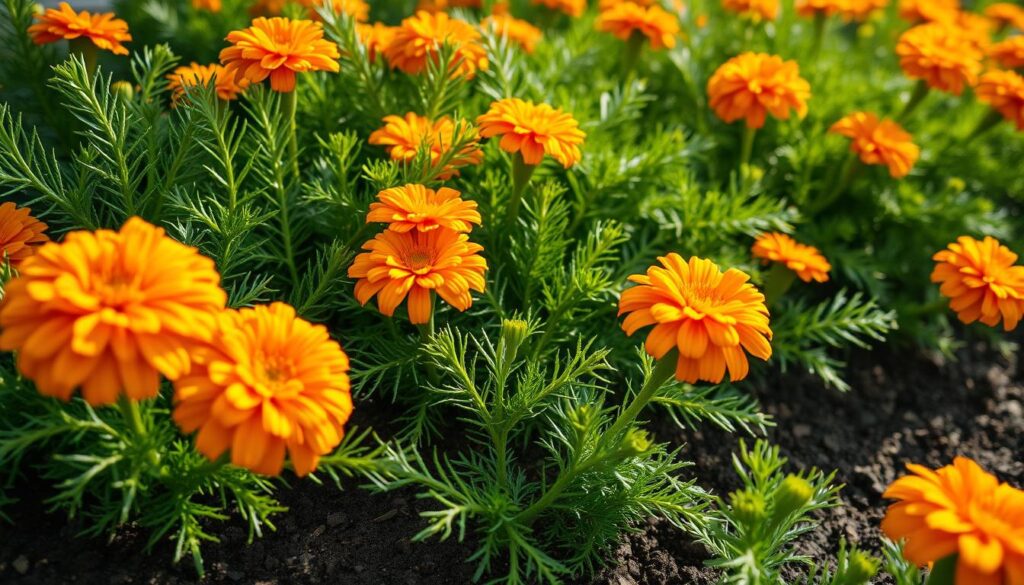
Troubleshooting Common Issues with Marigolds
Marigolds are generally easy to grow, yet they can encounter some common marigold issues that affect their health and beauty. Being aware of these problems can significantly improve your marigold plant care routine. Two typical issues include powdery mildew and root rot. Taking preventive measures and knowing how to address these concerns can keep your marigolds thriving.
Dealing with Powdery Mildew
Powdery mildew appears as a white, powdery substance on the leaves of marigolds. This fungal disease often occurs in warm, humid conditions, especially with poor air circulation. To combat this issue:
- Ensure proper spacing between plants to promote airflow.
- Avoid watering the foliage; water the soil directly.
- Remove affected leaves to prevent the spread of spores.
- Apply a fungicide if the problem persists, following the manufacturer’s instructions.
Preventing Root Rot in Marigolds
Root rot is another common issue, often caused by overwatering or poorly draining soil. Signs of root rot include yellowing leaves and wilting, even when the soil is moist. To prevent this problem:
- Water marigolds only when the top inch of soil feels dry.
- Ensure your planting area has good drainage; consider raised beds or pots with drainage holes.
- Improve soil structure by adding organic matter and ensuring proper aeration.
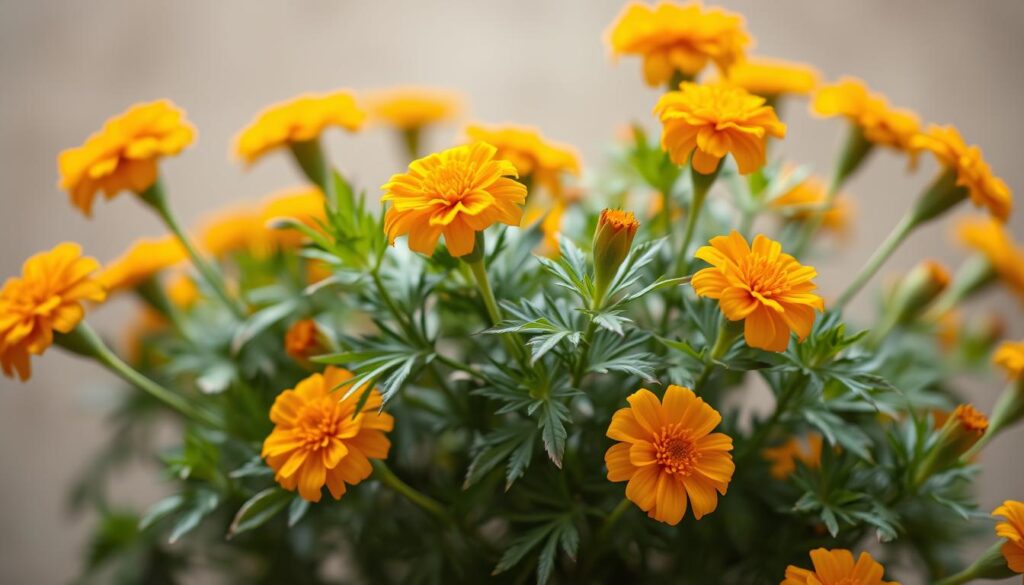
Harvesting from Your Companion Plant Garden
Engaging in the delightful activity of harvesting vegetables and flowers adds pleasure to your gardening experience. Timing plays a crucial role in maximizing flavor and freshness. With vegetables, knowing the right moment for picking can significantly affect your culinary outcomes. For marigolds, regular harvesting is beneficial, not only for beauty but also for encouraging new blooms.
Timing Your Vegetable Harvest
When it comes to harvesting vegetables, each type has its own signs of readiness. For example, tomatoes should be picked when they develop a rich color and give slightly to the touch. Cucumbers should be harvested before they become too large, ensuring they remain tender. Familiarize yourself with the ideal timing for each vegetable in your garden to enjoy peak flavor.
Tips for Picking Marigolds
When you’re picking marigolds, consider the timing of your harvest carefully. The best time to cut marigolds is early in the morning when the stems are firm and the flowers are fully open. Use a sharp pair of scissors or pruning shears to make a clean cut, which helps prevent damage to the plant. Regularly picking flowers not only beautifies your garden arrangements but supports ongoing blooming throughout the season.

| Vegetable | Signs of Readiness |
|---|---|
| Tomatoes | Rich color, slight softness |
| Cucumbers | Firm, not overly large |
| Peppers | Full size, glossy skin |
| Marigolds | Fully open blooms |
Creative Uses for Marigolds in Your Garden
Marigolds are more than just a beautiful addition to your garden. Their vibrant petals and practical uses make them a versatile choice for any gardener. Exploring the marigold petal uses opens up exciting possibilities in both cooking and garden maintenance. You can enjoy the benefits of marigolds while enhancing your landscape and culinary endeavors.
Marigold Petals in Cooking
The bright petals of marigolds can be harvested and incorporated into your meals. These edible flowers not only add a pop of color but also impart a subtle, peppery flavor to dishes. You might consider adding them to salads for an eye-catching presentation or using them to garnish soups and entrees. Their unique taste makes marigold petals a delightful ingredient in various culinary creations.
Using Marigolds as Natural Mulch
In addition to their culinary applications, marigolds serve effectively as natural garden mulch. By incorporating dried marigold petals around your plants, you can help retain soil moisture and prevent weed growth. This layer of petals not only protects the soil but also enhances the overall health of your garden. Embracing marigolds in this way demonstrates their dual purpose, making them an essential part of your gardening strategy.
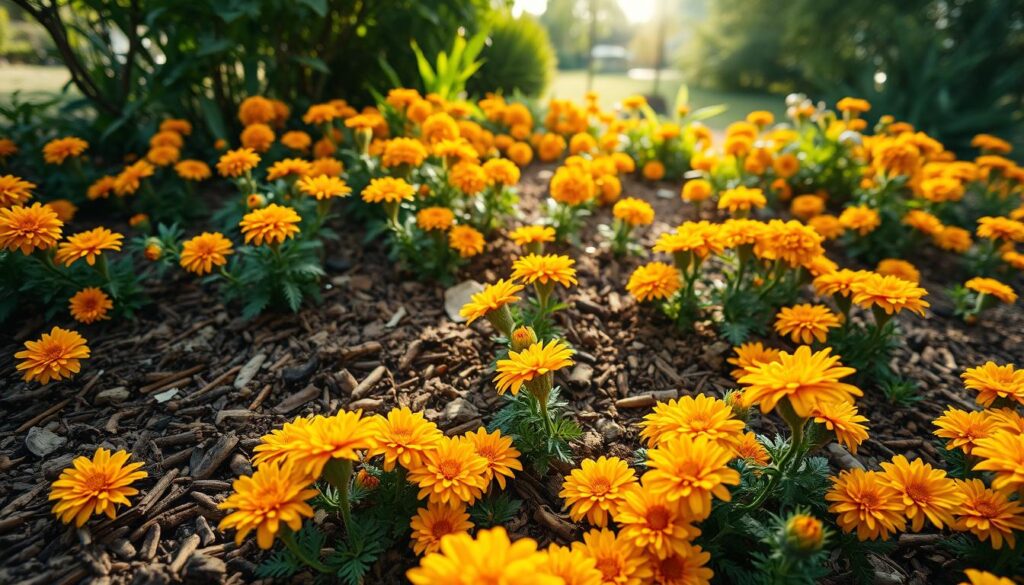
Conclusion: Your Marigold Companion Plant Journey
As you wrap up your exploration of marigold companion plants, it’s clear that the advantages they bring to your garden are significant. From repelling unwanted pests to enhancing the growth of neighboring vegetables and flowers, the benefits of marigolds are multifaceted. Their vibrant colors not only brighten your outdoor space but also attract beneficial insects, fostering a healthier ecosystem. Remember, each marigold variant offers unique strengths, making it essential to choose the right types for your specific gardening conditions.
Embracing the practice of companion planting with marigolds can truly transform your gardening experience. By pairing them with the right vegetables and flowers, you can cultivate a thriving garden that is both beautiful and productive. As you embark on this green journey, consider experimenting with different combinations and methods to maximize your results. Starting to plant marigolds alongside your favorite crops can be a rewarding endeavor that enhances not only your garden’s aesthetics but also its overall health.
So, gather your seeds, prepare your soil, and dive into the world of marigold companion planting. Enjoy the vibrant blooms and the many benefits of marigolds as you nurture your garden into a dynamic and lively environment. Happy planting!
